Woman presents with progressive unexplained visual loss in right eye
Humphrey visual fields revealed a dense central defect in the right eye and a superior temporal defect in the left eye.

 Isabel M. Balderas |  Tom Hsu | ||
A 69-year-old woman was referred for progressive visual loss in the right eye over the previous 6 months. She described the vision as distorted and “crinkly.”
An ophthalmologist had been following the patient regularly for pattern dystrophy, and her vision had been stable over the past 10 years. A retina specialist examined her 4 months earlier and suggested that the visual loss was likely related to pattern dystrophy or age-related macular degeneration with geographic atrophy. She sought another opinion from a second retina specialist and was subsequently referred for neuro-ophthalmic evaluation of unexplained visual loss of the right eye.
Medical history was significant for a seizure disorder that was controlled with oral phenobarbital. Family history was significant for macular degeneration. Social history was unremarkable, and her review of systems was negative.
Examination
Vision with spectacles measured counting finger at 8 inches in the right eye and 20/20 in the left eye. There was a 2+ relative afferent pupillary defect in the right eye. She saw none of the AOHRR color plates with the right eye and identified most with the left. Extraocular movements were full, and IOP was 16 mm Hg bilaterally. Anterior segment examination showed 1+ to 2+ nuclear sclerosis bilaterally and pseudoexfoliation in the right eye.
Fundus examination demonstrated retinal pigment epithelial and choroidal atrophy consistent with a pattern dystrophy involving both maculas. Fluorescein angiogram showed a patchy hyperfluorescent and hypofluorescent configuration corresponding to the retinal pigment epithelial atrophy in the macular region bilaterally (Figures 1a and 1b). Optical coherence tomography demonstrated inner segment and outer segment junction loss consistent with pattern dystrophy; macular edema was not exhibited. Humphrey visual fields showed a dense central defect in the right eye and a superior temporal defect in the left eye (Figures 2a and 2b).
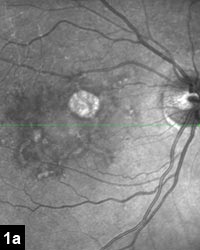 | 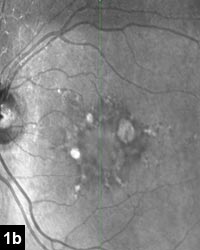 |
| Fluorescein angiogram demonstrating a patchy hyperfluorescent and hypofluorescent pattern bilaterally consistent with retinal pigment epithelial atrophy in pattern dystrophy. Images: Yoon SJ, Hedges TR | |
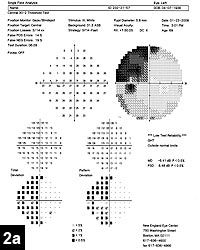 Humphrey visual field of the left eye showing a superior temporal defect. | 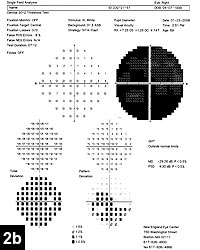 Humphrey visual field of the right eye showing a dense central defect. |

What is your diagnosis?
Vision loss
The combination of central visual field loss in one eye accompanied by a superior temporal defect in the other is referred to as a junctional scotoma. This pattern is thought to result from involvement and/or compression of one optic nerve at its junction with the chiasm. Wilbrand, in 1904, proposed that this clinical syndrome was caused by involvement of the crossing fibers as they loop forward into the contralateral optic nerve, or Wilbrand’s knee. The differential diagnosis includes neoplastic processes such as a pituitary adenoma, meningioma, glioma, craniopharyngioma or chordoma, as well as vascular lesions such as suprasellar carotid aneurysm or cavernous hemangioma. Rare causes are infectious or inflammatory lesions such as syphilis, tuberculosis, sarcoidosis or histiocytosis X, or congenital lesions such as an arachnoid cyst or Rathke cleft cyst.
Diagnosis
MRI in our patient demonstrated a large — 5.5 cm × 4.1 cm × 4.2 cm — enhancing mass involving the right orbital apex and right cavernous sinus extending to the sella, with elevation of the right and central portions of the chiasm along with encasement of the carotid artery (Figure 3). This lesion was most consistent with a meningioma with cystic components. The patient was referred to neurosurgery for further management.
Discussion
After examining two cadaver specimens that underwent enucleation before death, Hermann Wilbrand observed a small bundle of fibers from the inferonasal aspect of the optic nerve that looped forward into the contralateral atrophic optic nerve before reaching the chiasm. He theorized that a focal lesion affecting the anterior and inferior optic nerve chiasm would produce a characteristic visual field defect with an ipsilateral central scotoma and a contralateral superotemporal defect. Traquair referred to this as a junctional scotoma.
 Large enhancing mass involving the right orbital apex and right cavernous sinus extending to the sella, with elevation of the right and central portion of the chiasm and vascular encasement. Consistent with a meningioma with cystic components. | ||
More recently, the existence of Wilbrand’s knee fibers has been called into question. In 1997, Horton argued that Wilbrand’s knee was an artifact of enucleation. He performed a study on rhesus and squirrel monkeys and proposed that Wilbrand’s knee was the result of traction on the contralateral decussating inferonasal fibers caused by atrophy of the ipsilateral optic nerve of the enucleated eye. This was demonstrated to be a time-dependent process that did not occur prior to 6 months after enucleation but was clearly evident after 6 months. Horton also demonstrated this optic nerve atrophy-related distortion to occur in human cadavers at the time of autopsy.
Schiefer in 2003 performed a study concerning the distribution of scotoma patterns in 153 consecutive patients with chiasmal lesions. Visual field patterns included bitemporal hemianopia (22%), anterior junction syndrome (13%), homonymous hemianopia (11%) and monocular defects not respecting vertical meridian (9%). An anterior junction syndrome was defined as a monocular field loss combined with field defect respecting the vertical midline in the fellow eye. This syndrome was the second most common visual field pattern of those with chiasmal lesions in this study. Although this does not validate the existence of Wilbrand’s knee, it clinically indicates the close proximity of the prechiasmal optic nerve and the decussating inferonasal fibers of the fellow eye. Although Wilbrand’s knee may be an artifact of enucleation, the localizing value remains important regardless of whether the knee exists anatomically or not.
Management
Skull-based meningiomas are often extensive, invasive and intimately associated with cranial nerves, vasculature or the brainstem. Small asymptomatic tumors may be managed conservatively with observation, particularly in elderly or sick patients. Tumors showing rapid growth, surrounded by significant edema or likely to be symptomatic over the next several years need to be managed more aggressively. Surgical excision, with a subtotal resection to protect adjacent structures, is possible in select cases. Image-guided surgery with frameless stereotactic radiosurgery has provided enhanced surgical confidence and accuracy with meningiomas previously thought to be inoperable. External beam fractionated radiotherapy has also shown to be effective in controlling subtotally resected or recurrent meningiomas. Chemotherapy, however, has had disappointing results with skull-based meningiomas. The management of meningiomas should be individualized to each patient based on tumor size, location and proximity to adjacent structures. It may involve a combination of all of the treatment modalities discussed above.
Our patient was referred to neurosurgery, and surgical resection was recommended based on tumor size, compression on the right optic nerve and chiasm, and progressive visual symptoms. She underwent a right, orbital-frontal, zygomatic craniotomy with a subtotal resection of the complex skull-based meningioma. Residual tumor was left in the cavernous sinus, sella and sphenoid sinus to preserve cranial nerves III, V and VI as well as pituitary function. She tolerated the procedure well and had considerable improvement in the vision of her right eye (counting fingers to 20/70) and visual fields (Figures 4a and 4b) at the 2-month postop visit. She will be evaluated in the coming months to undergo adjunctive radiotherapy for the residual tumor.
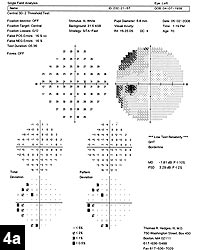 Humphrey visual field of the left eye showing improvement of the superior temporal defect at the 2-month postop visit. | 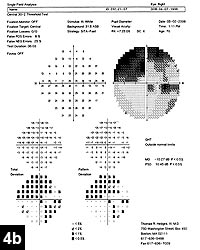 Humphrey visual field of the right eye showing improvement of the dense central defect at the 2-month postop visit. | |
For more information:
- Steven J. Yoon, MD, and Thomas R. Hedges III, MD, can be reached at New England Eye Center, Tufts University School of Medicine, 750 Washington St., Box 450, Boston, MA 02111; 617-636-4219; fax: 617-636-4866; Web site: www.neec.com
- Edited by Isabel M. Balderas, MD, and Tom Hsu, MD. Drs. Balderas and Hsu can be reached at New England Eye Center, Tufts University School of Medicine, 750 Washington St., Box 450, Boston, MA 02111; 617-636-4219; fax: 617-636-4866; Web site: www.neec.com. Drs. Balderas and Hsu have no direct financial interest in the products mentioned in this article, nor are they paid consultants for any companies mentioned.
References:
- Drummond KJ, Zhu JJ, Black P. Meningiomas: updating basic science, management and outcome. Neurologist. 2004; 10(3):113-130.
- Horton, JC. Wilbrand’s knee of the primate optic chiasm is an artefact of monocular enucleation. Trans Am Ophthalmol Soc. 1997;95:579-609.
- Lee JH, Tobias S, et al. Wilbrand’s knee: does it exist. Surg Neurol. 2006;66(1):11-17.
- Schiefer U, Isbert M, et al. Distribution of scotoma pattern related to chiasmal lesions with special reference to anterior junction syndrome. Graefes Arch Clin Exp Ophthalmol. 2004;242(6):468-477.
- Traquair HM. An Introduction to Clinical Perimetry. St Louis: CV Mosby Co.; 1927:98-120
- Wilbrand H, Saenger A. Die Neurologie des Auges. Wiesbaden: J Bergmann; 1904:98-120.









